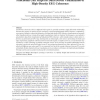Free Online Productivity Tools
i2Speak
i2Symbol
i2OCR
iTex2Img
iWeb2Print
iWeb2Shot
i2Type
iPdf2Split
iPdf2Merge
i2Bopomofo
i2Arabic
i2Style
i2Image
i2PDF
iLatex2Rtf
Sci2ools
VISSYM
2007
2007
Functional Unit Maps for Data-Driven Visualization of High-Density EEG Coherence
Synchronous electrical activity in different brain regions is generally assumed to imply functional relationships between these regions. A measure for this synchrony is electroencephalography (EEG) coherence, computed between pairs of signals as a function of frequency. Existing high-density EEG coherence visualizations are generally either hypothesis-driven, or data-driven graph visualizations which are cluttered. In this paper, a new method is presented for data-driven visualization of high-density EEG coherence, which strongly reduces clutter and is referred to as functional unit (FU) map. Starting from an initial graph, with vertices representing electrodes and edges representing significant coherences between electrode signals, we define an FU as a set of electrodes represented by a clique consisting of spatially connected vertices. In an FU map, the spatial relationship between electrodes is preserved, and all electrodes in one FU are assigned an identical gray value. Adjacent F...
| Added | 30 Sep 2010 |
| Updated | 30 Sep 2010 |
| Type | Conference |
| Year | 2007 |
| Where | VISSYM |
| Authors | Michael ten Caat, Natasha M. Maurits, Jos B. T. M. Roerdink |
Comments (0)

